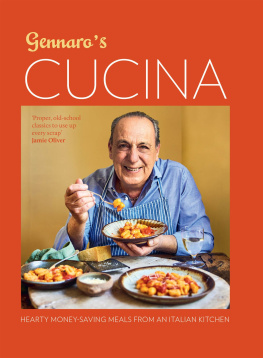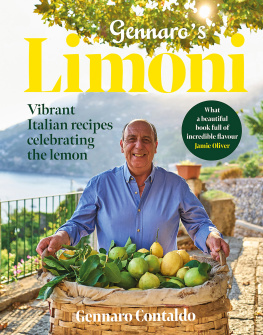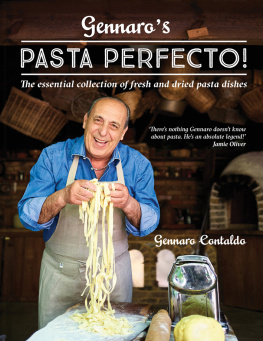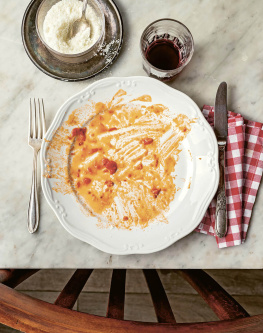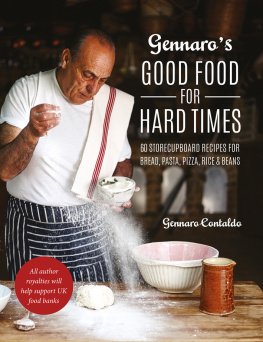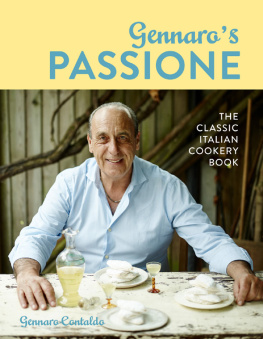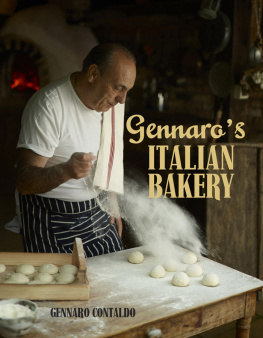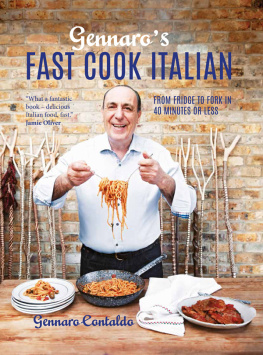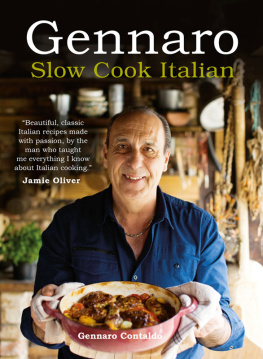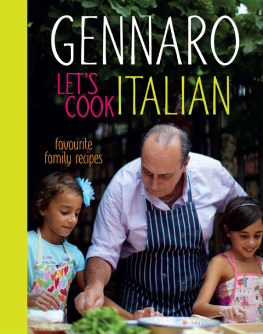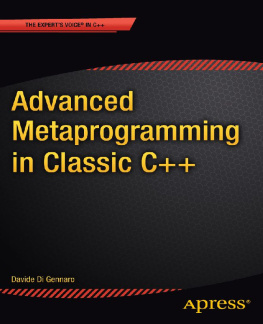Gennaro Contaldo - Gennaros Cucina
Here you can read online Gennaro Contaldo - Gennaros Cucina full text of the book (entire story) in english for free. Download pdf and epub, get meaning, cover and reviews about this ebook. year: 2022, publisher: HarperCollins Publishers, genre: Home and family. Description of the work, (preface) as well as reviews are available. Best literature library LitArk.com created for fans of good reading and offers a wide selection of genres:
Romance novel
Science fiction
Adventure
Detective
Science
History
Home and family
Prose
Art
Politics
Computer
Non-fiction
Religion
Business
Children
Humor
Choose a favorite category and find really read worthwhile books. Enjoy immersion in the world of imagination, feel the emotions of the characters or learn something new for yourself, make an fascinating discovery.
- Book:Gennaros Cucina
- Author:
- Publisher:HarperCollins Publishers
- Genre:
- Year:2022
- Rating:5 / 5
- Favourites:Add to favourites
- Your mark:
- 100
- 1
- 2
- 3
- 4
- 5
Gennaros Cucina: summary, description and annotation
We offer to read an annotation, description, summary or preface (depends on what the author of the book "Gennaros Cucina" wrote himself). If you haven't found the necessary information about the book — write in the comments, we will try to find it.
Gennaros Cucina — read online for free the complete book (whole text) full work
Below is the text of the book, divided by pages. System saving the place of the last page read, allows you to conveniently read the book "Gennaros Cucina" online for free, without having to search again every time where you left off. Put a bookmark, and you can go to the page where you finished reading at any time.
Font size:
Interval:
Bookmark:
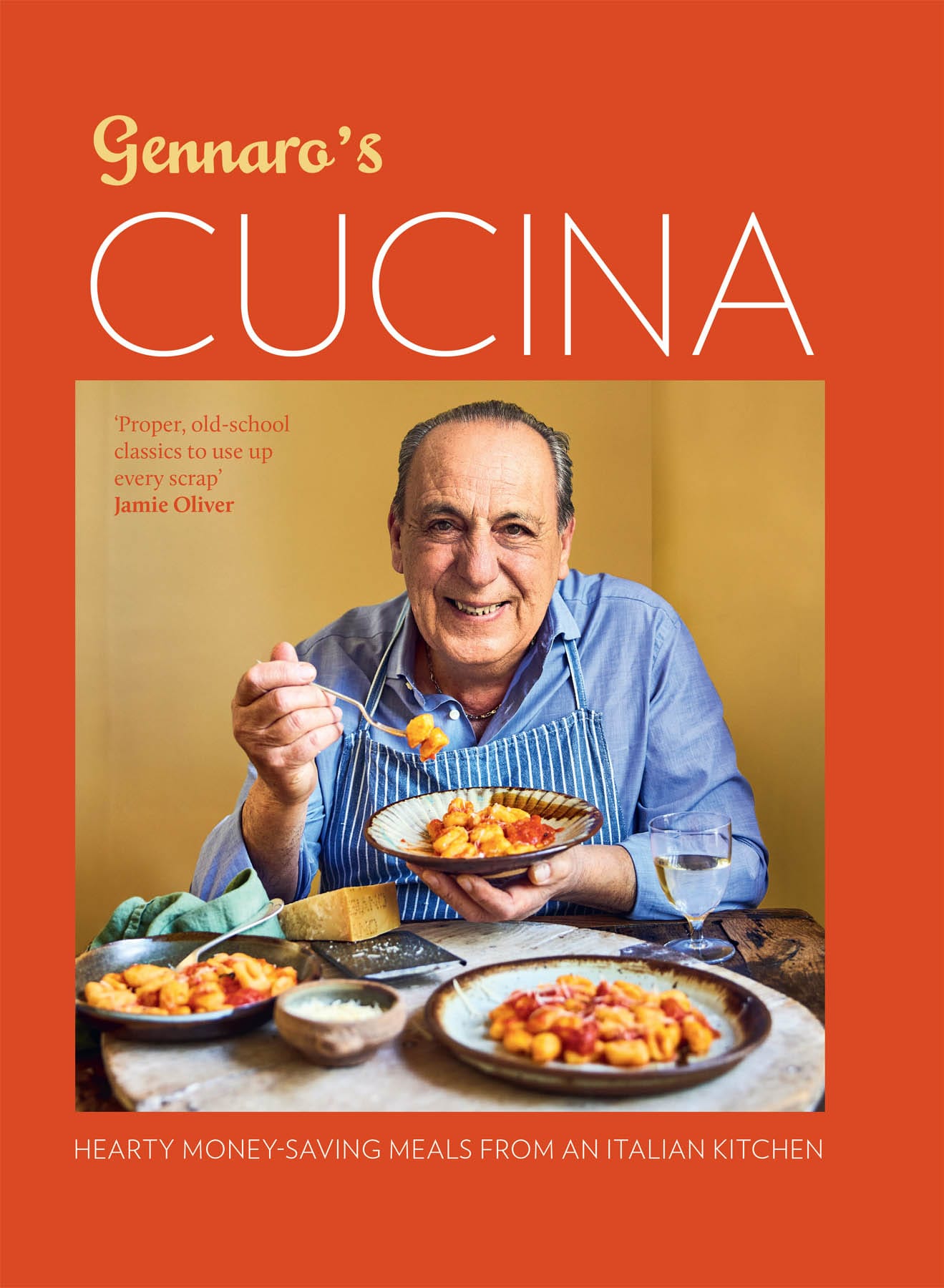


WHEN USING KITCHEN APPLIANCES PLEASE ALWAYS FOLLOW THE MANUFACTURERS INSTRUCTIONS
HarperCollinsPublishers Ltd
1 London Bridge Street
London SE1 9GF
www.harpercollins.co.uk
HarperCollinsPublishers
Macken House
39/40 Mayor Street Upper
Dublin 1
D01 C9W8
Ireland
First published in Great Britain by Pavilion, an imprint of HarperCollinsPublishers Ltd 2023
First published in 2023 by Harper Design
An imprint of HarperCollinsPublishers
195 Broadway
New York, NY 10007
Text Copyright Gennaro Contaldo 2023
Gennaro Contaldo asserts the moral right to be identified as the author of this work. A catalogue record for this book is available from the British Library.
Hardback ISBN: 9781911682608
eBook ISBN: 9781911670216
Version date: 2022-12-13
All rights reserved. No part of this publication may be reproduced, stored in a retrieval system, or transmitted, in any form or by any means, electronic, mechanical, photocopying, recording or otherwise, without the prior permission of the publishers.
This ebook contains the following accessibility features which, if supported by your device, can be accessed via your ereader/accessibility settings:
- Change of font size and line height
- Change of background and font colours
- Change of font
- Change justification
- Text to speech
- Page numbers taken from the following print edition: ISBN 9781911682608

Cucina povera is the basis from which all our favourite Italian dishes come from. Its the sort of cooking I was brought up on and still cook today. It originates mainly from rural areas, where meals were created using the limited number of ingredients available either what people grew or what little they could afford to buy. In doing so, they learnt to value what they had and to lovingly cook dishes to ensure they tasted better, using all their imagination to make dishes go as far as they could.
The seasons played an important part, bringing an abundance of particular produce at certain times of the year in different regions of the country. Therefore, people had to find creative ways to cook the produce, so that a surplus would never be wasted and instead was preserved to enjoy at other times of the year. This is how salting fish or curing meats came about, hence the abundance of cured meats in Italian delis today. A glut of vegetables would be preserved in oil, and the end-of-summer tomatoes placed in glass bottles or fruit drying in the sun were familiar, annual rituals for most Italian families.
Pasta, simply made with flour and water, forms a huge part of the rustic Italian kitchen. Shapes such as orecchiette from Puglia or trofie in Liguria form the basis of many delicious regional dishes, which over time have become renowned outside of Italy, too. Pasta was traditionally the main staple of the south, whereas in the north, rice and polenta were eaten more readily. This is where risotto and the delicious gooey and baked polenta dishes stem from.
Bread, which we often take for granted these days, as toast for breakfast or a quick sandwich at lunchtime, has always been an important food in Italy. No Italian meal would be complete without bread on the table, but it is also put to good use in recipes. Stale bread is never wasted think of Tuscan Panzanella Salad, drizzled with olive oil and combined with tomatoes and olives. In Puglia, a dish called Panecotto is very popular and comprises stale bread cooked in a broth, perhaps with the addition of vegetables. Many soups are made with bread Tuscan Ribollita or Pappa al Pomodoro to name just two each region having its own version.
Bread is also used as a filling to stuff vegetables or added to meatballs to replace some of the meat. In Sicily, breadcrumbs are used to sprinkle over pasta, often in place of cheese.


Whenever I have stale bread, I make breadcrumbs, which I then store in containers to use for coating meat or fish or sprinkling on baked dishes or pasta. Bread dough was never wasted either; pizza makers in Naples would fry scraps of dough, which were topped with tomato sauce and cheese, and known locally as Diavulilli or Angiolilli.
Throughout Italy, recipes often include the name Scappati or Fuggiti, meaning escaped the escape refers to a particular meat or fish which has magically escaped, because it wasnt there in the first place as it was probably too expensive to buy.
In Naples, when you couldnt afford the clams for Spaghetti alle Vongole, all the other ingredients were added, but they said the vongole had escaped! There is also a recipe from Castellamare di Stabia for seafood pasta, called Pasta con i Sassi, which uses pebbles from the sea to flavour the pasta water I can only assume and hope the pebbles were removed before serving!
Cheaper cuts of meat and offal were often used to create wonderful dishes think of slow-cooked rags and stews made with these. Offal was often sold very cheaply or even given away by butchers who sold meat to the rich. The offal would be made into dishes like the spicy Neapolitan Soffritto made with lots of herbs and chilli to mask the flavour; Trippa (tripe) was made into various dishes all over Italy; also Fegato alla Veneziana liver cooked with lots of onions, from Venice. No part of the animal was ever wasted and even pigs blood was used to make chocolate. A lot of these dishes still exist today and have also become gourmet delicacies.
Fish was often dried and salted so it could be kept for long periods. Baccal (salt cod) or Stoccafisso (air-dried cod) are both prime examples of how this food of the poor has become so popular and now commands such high prices. It has now become the food of the rich, and it is a treat to enjoy this cured fish, especially at Christmastime. Baccal is eaten throughout the regions of Italy in a variety of ways. In Venice, it is cooked in milk, then reduced to a mushy consistency with olive oil and garlic and served on grilled polenta. In Liguria, it is cooked with potatoes, and in Naples, it is cooked in a tomato sauce.
Beans and pulses are widely used in Italian cooking and this probably dates back to when meat prices were so prohibitive. Italians love thick, bean-based soups and pasta dishes, and each region has its own specialities, made using whatever beans or pulses are locally grown, along with other ingredients that are popular in that particular area. Beans and pulses are a great source of protein, they are economical and can be used to create some truly lovely meals.
The sheer simplicity and deliciousness of these humble dishes never ceases to amaze me and they give such a great insight into the resourcefulness of the once-poor people of Italy. In recent years, this type of cooking has become very fashionable and can now be enjoyed in some of the best restaurants, often commanding high prices. For these dishes to be cooked at home, as well as in top restaurants, surely indicates that the poor Italians of years ago actually ate very well!
Font size:
Interval:
Bookmark:
Similar books «Gennaros Cucina»
Look at similar books to Gennaros Cucina. We have selected literature similar in name and meaning in the hope of providing readers with more options to find new, interesting, not yet read works.
Discussion, reviews of the book Gennaros Cucina and just readers' own opinions. Leave your comments, write what you think about the work, its meaning or the main characters. Specify what exactly you liked and what you didn't like, and why you think so.

